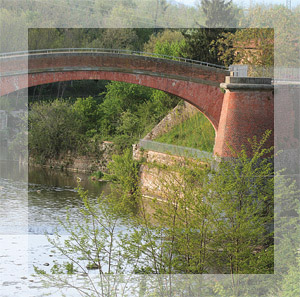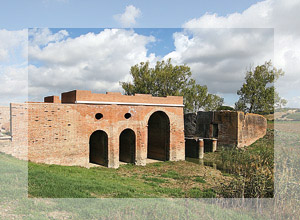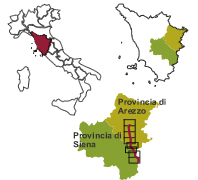CANALE MAESTRO DELLA CHIANA
[Master Canal of the Chiana Area]
By bike through the Tuscany of nature and of man
 Welcome to this broad valley, much loved by cyclists. This area is a sort of an ideal bridge connecting Arezzo, Siena and Umbria
Welcome to this broad valley, much loved by cyclists. This area is a sort of an ideal bridge connecting Arezzo, Siena and Umbria
The bicycle ride along the Canale Maestro della Chiana is a journey through time and nature: you can pedal right through the heart of the Etruscan world, across a myriad of waterways, in a land that has been shaped by the strength of nature and by the hands of man.
The Tuscan Grand Duke Leopoldo’s hydraulic engineers were the brains behind an impressive work of land reclaiming drainage which completely turned this area into an important agricultural centre; even today, its local economy is intimately tied to local produce, which you can observe by cycling through the roads of cheese and fruit, oil and wine. Between Arezzo and Chiusi, there are multiple ways of entering into the heart of an area that has to be thoroughly appreciated, to be lived in, recalling its history and its art, along the century-old waterways, letting yourself be tempted by the wonders of these lands which, apart from how they are usually considered, have a certain smell in the air, a perfume of their own true authenticity.
The Canale Maestro della Chiana
The Canale Maestro della Chiana’s cycle and pedestrian path which joins Arezzo to Chiusi is about 62 km long, and is equipped and protected for those who wish to travel slowly, either by bike or on foot. The ancient road used for both canal and lock maintenance is, in fact, a natural track without any height or level differences which makes it particularly suitable for family sporting tourism, and can be ideally combined with the railway line which serves the Val di Chiana between Arezzo and Chiusi.
Apart from its history and its landscape, this cycle path that crosses the Val di Chiana, is characterized by its important tourist identity in the sense that it is an area that can be fully used and enjoyed; this is frequently the case of other  European cycle paths, made for those who wish to travel slowly, using the bicycle as a means of getting to know the area properly. Its essentially flat land renders it ideal for families with children. In other words, the well-known Tuscany of hills and mountains that usually calls for legs which are used to altitude changes, opens out and becomes a friend even to those cyclists who are not particularly or athletically trained. The Canale Maestro della Chiana’s cycle and pedestrian path acts also as an opportunity of coming into close contact with the locals and their homelands, who can tell you all about their area, rich in the production of wine, oil and fruit.
European cycle paths, made for those who wish to travel slowly, using the bicycle as a means of getting to know the area properly. Its essentially flat land renders it ideal for families with children. In other words, the well-known Tuscany of hills and mountains that usually calls for legs which are used to altitude changes, opens out and becomes a friend even to those cyclists who are not particularly or athletically trained. The Canale Maestro della Chiana’s cycle and pedestrian path acts also as an opportunity of coming into close contact with the locals and their homelands, who can tell you all about their area, rich in the production of wine, oil and fruit.
By following the cycle paths, you can discover wine cellars, squares, oil mills, craftsmen, all ignored by traditional tourist itineraries. It is a sort of preferential route towards the heart of a valley, passed through by many but little known by those who cross it by car or train, heading towards a Tuscany that is still to be discovered and appreciated. This route, combined with train transport, enables you to cover the whole way without having to go back over your own steps; and the services available (bike rental, luggage transport, help centres and specialized tourist-accommodation facilities along the way) create a cycle path which is a point of reference in the heart of Tuscany, and which can easily be reached by train arriving at the stations of Chiusi Chianciano Terme and Arezzo. Short detours off the main route allow you to make a real journey of discovery through the art cities of Montepulciano and Chiusi, Arezzo, Castiglion Fiorentino and Cortona.



















 Informacion
Informacion Informations
Informations Informatie
Informatie Informationen
Informationen






 Welcome to this broad valley, much loved by cyclists. This area is a sort of an ideal bridge connecting Arezzo, Siena and Umbria
Welcome to this broad valley, much loved by cyclists. This area is a sort of an ideal bridge connecting Arezzo, Siena and Umbria European cycle paths, made for those who wish to travel slowly, using the bicycle as a means of getting to know the area properly. Its essentially flat land renders it ideal for families with children. In other words, the well-known Tuscany of hills and mountains that usually calls for legs which are used to altitude changes, opens out and becomes a friend even to those cyclists who are not particularly or athletically trained. The Canale Maestro della Chiana’s cycle and pedestrian path acts also as an opportunity of coming into close contact with the locals and their homelands, who can tell you all about their area, rich in the production of wine, oil and fruit.
European cycle paths, made for those who wish to travel slowly, using the bicycle as a means of getting to know the area properly. Its essentially flat land renders it ideal for families with children. In other words, the well-known Tuscany of hills and mountains that usually calls for legs which are used to altitude changes, opens out and becomes a friend even to those cyclists who are not particularly or athletically trained. The Canale Maestro della Chiana’s cycle and pedestrian path acts also as an opportunity of coming into close contact with the locals and their homelands, who can tell you all about their area, rich in the production of wine, oil and fruit.